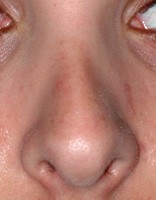Inverted V Deformity
 The inverted V deformity is a classic post-rhinoplasty aesthetic (cosmetic) complication but can also be caused by trauma to the nose. It may also cause breathing problems via internal nasal valve collapse. It is a sign that the middle vault of the nose has collapsed inwards.
The inverted V deformity is a classic post-rhinoplasty aesthetic (cosmetic) complication but can also be caused by trauma to the nose. It may also cause breathing problems via internal nasal valve collapse. It is a sign that the middle vault of the nose has collapsed inwards.
What causes an inverted V deformity?
The inverted V deformity appearance is caused by the caudal (lower) edge of the nasal bones becoming visible where it joins with the upper lateral cartilages. Normally there is a smooth transition from bone to cartilage. Unfortunately after a hump is removed if adequate reconstruction is not performed at the time of hump removal the tissues under the hump can sink inwards. This is called middle vault collapse. The collapsed tissues consist of the upper lateral cartilage and nasal septum.
How do we fix the inverted V deformity?
Spreader grafts are the best way to fix the inverted V deformity. If the tip of the nose has also rotated upwards or dropped, extended spreader grafts attached to a new columellar strut may be necessary.
A closed approach or open approach rhinoplasty is necessary often in combination with a nasoseptal reconstruction. Occasionally a non-surgical rhinoplasty using a filler can be used to camouflage the inverted V deformity.

